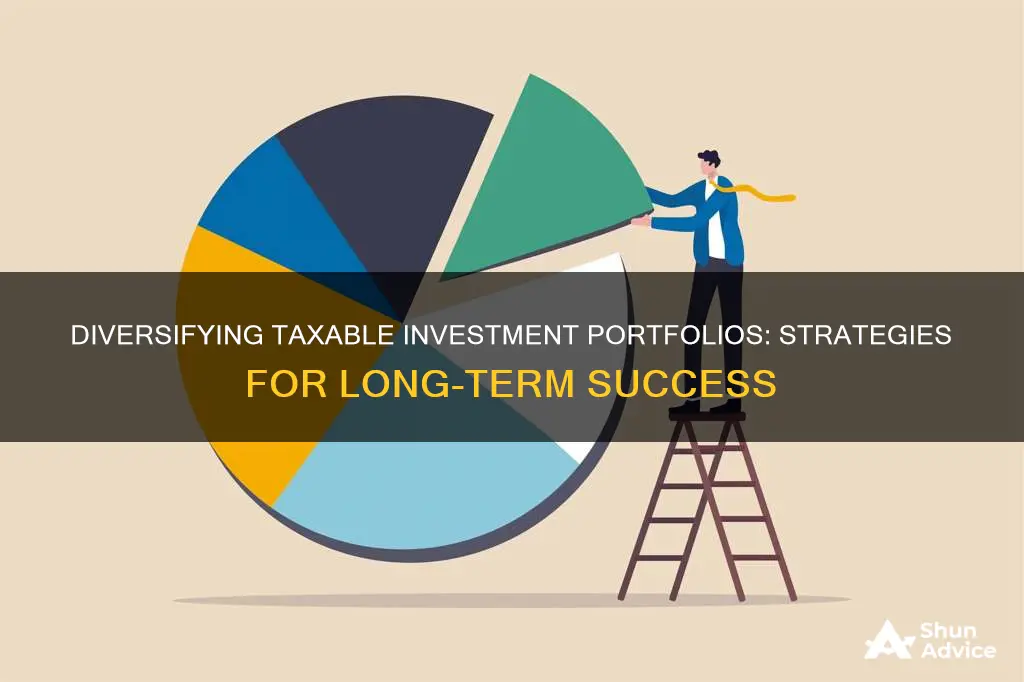
Diversifying an investment portfolio is a crucial strategy to reduce risk and increase returns. The old adage don't put all your eggs in one basket aptly describes the logic behind diversification. By spreading your investments across various assets, industries, and markets, you can lower the overall risk and smooth out the peaks and valleys of your investment journey. Here are some key strategies to help you diversify your taxable investment portfolio:
1. Individual Asset Diversification: Invest in a range of assets within different classes, such as stocks, bonds, cash, and alternative investments. Diversify across high- and low-risk stocks from various industries, including tech, energy, and healthcare.
2. International Market Diversification: Look beyond your country's borders and invest in international markets. This helps mitigate risk and balance your portfolio, especially if your country's market experiences a downturn.
3. Asset Class Diversification: Invest across traditional and alternative asset classes. Traditional investments include stocks, bonds, and cash, while alternative investments may encompass hedge funds, private equity, real estate, debt investing, commodities, and collectibles.
4. Tax Diversification: Consider the tax treatment of specific assets and accounts. Utilize a combination of fully taxable, tax-advantaged, and tax-free investment accounts to optimize your tax burden both in the short and long term.
5. Index Funds and ETFs: Investing in index funds or exchange-traded funds (ETFs) that track broad indexes like the S&P 500 is a low-cost way to quickly diversify your portfolio. These funds offer instant diversification and have very low expense ratios.
6. Real Estate: Consider adding real estate to your portfolio through real estate investment trusts (REITs). REITs have historically increased total returns while reducing volatility.
7. Fixed Income: Allocate a portion of your portfolio to fixed-income assets like bonds to lower volatility and overall risk. While this may reduce average annual returns, it can mute losses during market downturns.
8. Periodic Rebalancing: Regularly review and rebalance your portfolio to maintain the appropriate weight for each investment. This ensures that your portfolio remains diversified as the size of holdings will change over time based on their performance.
9. Global Perspective: Don't forget about investment opportunities outside your home country. Explore funds focused on emerging markets or other regions to take advantage of global economic growth and protect yourself from country-specific negative events.
10. Cash: Include cash or cash equivalents in your portfolio as it can provide protection during market downturns and offer optionality, allowing you to take advantage of future investment opportunities.
| Characteristics | Values |
|---|---|
| Number of investments | 20-30 different investments |
| Types of investments | Equities, commodities, exchange-traded funds (ETFs), real estate investment trusts (REITs), index funds, bond funds, mutual funds, securities, cash, international markets, alternative investments, fixed-income assets, target-date funds |
| Risk | Higher-risk investments include stocks, especially in a single industry or sector. Lower-risk investments include fixed-income assets like bonds. |
| Returns | Higher-return investments include stocks, especially in a single industry or sector. Lower-return investments include fixed-income assets like bonds. |
| Correlation | Choose investments that are not closely correlated to reduce risk. |
| Taxes | Tax-advantaged, fully taxable, and tax-free accounts can be used together for tax diversification. |
| Time horizon | Include investments with different time horizons to provide flexibility and security. |
| Liquidity | Include liquid investments to allow for more flexibility. |
What You'll Learn

Invest in at least 25 stocks from various industries
Diversifying your investment portfolio is a crucial strategy to reduce risk and optimise returns. Here are some detailed guidelines on how to achieve diversification by investing in at least 25 stocks across various industries:
Understand the Importance of Diversification:
Diversification is a fundamental concept in investing, often summed up as "don't put all your eggs in one basket." By spreading your investments across numerous stocks from different industries, you reduce the risk associated with concentrating your investments in a single or a few sectors. This strategy helps protect your portfolio from significant losses if a particular stock or industry underperforms.
Determine Your Investment Goals:
Before investing, clearly define your short-term and long-term financial objectives. For example, you may be saving for a house, planning for retirement, or funding your child's education. These goals will influence your investment strategy, including the types of stocks and industries you choose to invest in.
Assess Your Risk Tolerance:
Understanding your risk tolerance is crucial when diversifying your portfolio. Are you comfortable with higher risks for potentially greater returns, or do you prefer stability? Your risk tolerance often depends on your investment timeline, with longer horizons allowing for more risk-taking.
Choose a Variety of Industries:
When selecting stocks, aim for a diverse range of industries. Consider sectors such as technology, healthcare, energy, financials, consumer goods, aerospace, defence, telecommunications, and more. By investing across multiple industries, you reduce the impact of a downturn in any single sector on your portfolio.
Look for Complementary Investments:
When choosing stocks within each industry, consider those that complement each other. For example, investing in a package delivery company and a videoconferencing platform means that a gas shortage could negatively impact the former while positively affecting the latter. This complementary approach helps decrease your portfolio's overall risk.
Monitor and Rebalance Your Portfolio:
Diversification is an ongoing process. Regularly review and adjust your portfolio to ensure it aligns with your investment goals and risk tolerance. Monitor the performance of your stocks and industries and periodically rebalance to maintain your desired allocation across sectors.
Consider Other Diversification Strategies:
In addition to investing in a variety of industries, you can further diversify by including different types of investments, such as bonds, exchange-traded funds (ETFs), mutual funds, and alternative investments like real estate or commodities.
Remember, diversification is a powerful tool to manage risk and optimise returns, but it does not guarantee profits or completely eliminate losses. It's essential to conduct thorough research, monitor your investments, and seek professional advice when needed to make informed investment decisions.
Savings: Exploring Investment Options Beyond Fixed Deposits
You may want to see also

Include fixed-income assets like bonds
Fixed-income assets, such as bonds, are an important component of a well-diversified investment portfolio. These investments provide a fixed interest rate or regular dividend payments to investors and are considered less volatile than equities. Here are some reasons why including fixed-income assets like bonds in your taxable investment portfolio can be beneficial:
Stability and Risk Mitigation
Fixed-income investments, particularly government and corporate bonds, offer stability and lower risk compared to stocks. They provide a steady stream of income through fixed interest or dividend payments, making them attractive for conservative investors or those seeking to balance their portfolio. The stable income helps stabilize the risk-return profile of your portfolio, offsetting potential losses from stock price fluctuations.
Tax Advantages
Bonds and other fixed-income investments can offer tax advantages, depending on the type of account you hold them in. For example, municipal bonds are often tax-exempt at the federal and state levels, providing tax-free income. Additionally, tax-deferred accounts, such as traditional 401(k)s and IRAs, allow you to delay tax payments until withdrawal, which can be beneficial if you expect your marginal tax rate to be lower in the future.
Diversification within Fixed-Income
Diversification is not limited to different asset classes; it also applies within the fixed-income category. You can diversify your fixed-income holdings by investing in a range of products, such as Treasury bills, notes, and bonds, corporate bonds, certificates of deposit (CDs), and more. Each of these products has unique benefits and limitations, allowing you to tailor your fixed-income allocation to your specific needs and risk tolerance.
Long-Term Investment Horizons
Fixed-income investments typically have longer investment horizons, providing the opportunity for compound interest to work in your favor. This is especially beneficial if you are investing for the long term, such as for retirement. The stable and predictable income generated by fixed-income assets can be advantageous for retirement portfolios, providing a reliable income stream.
Professional Management
If selecting individual bonds seems daunting, you can consider investing in fixed-income mutual funds or exchange-traded funds (ETFs). These funds are professionally managed and provide exposure to a diverse range of bonds and debt instruments. Mutual funds and ETFs offer the benefits of diversification and professional management, making them a practical and cost-efficient way to invest in fixed-income securities.
Building a Million-Dollar Investment Portfolio: Strategies for Success
You may want to see also

Add real estate through REITs
Real estate is an important asset class that can help diversify your portfolio and reduce risk. One way to add real estate to your portfolio is through Real Estate Investment Trusts (REITs).
REITs are companies that own, finance, or manage income-producing real estate across a range of sectors, including residential, commercial, or retail properties. They are traded on major stock exchanges and offer benefits such as high dividend yields and long-term capital appreciation.
There are different types of REITs to consider, including:
- Residential REITs: These focus on multi-family rental apartment buildings and manufactured housing.
- Healthcare REITs: These invest in the real estate of hospitals, medical centres, nursing facilities, and retirement homes.
- Office REITs: These receive rental income from tenants in office buildings, usually through long-term leases.
- Mortgage REITs: These invest in mortgages and mortgage-backed securities instead of equity.
When investing in REITs, it is important to consider factors such as the quality of the properties and tenants, the financial health of the company, and the management team's experience. Additionally, REITs have tax implications, as their dividends are typically taxed at a higher rate.
By adding real estate through REITs, you can further diversify your portfolio, reduce risk, and increase the potential for long-term returns.
Investing While Saving for a Home: Wise or Risky?
You may want to see also

Diversify your investments for more tax-efficient investing
Diversifying your investments is a great way to reduce your tax burden and keep more of your money. Here are some strategies to help you diversify your investments for more tax-efficient investing:
Understand Tax Diversification
Tax diversification involves considering the tax treatment of specific assets and accounts. The goal is to reduce your long-term tax liability while maintaining liquidity for short-term expenses. There are three types of investment accounts to consider: fully taxable, tax-advantaged, and tax-free. Understanding these categories will help you build a tax-efficient portfolio.
Create Different Tax 'Buckets'
Consider contributing to both traditional tax-advantaged accounts, such as 401(k)s or IRAs, and tax-free accounts, such as Roth IRAs or Roth 401(k)s. By diversifying across these account types, you can reduce your overall tax burden. When you reach retirement age, withdraw just enough from your tax-advantaged accounts to stay in a lower tax bracket, and then tap into your tax-free accounts.
Anticipate Your Future Tax Bracket
If you're early in your career and expect your income to increase over time, prioritizing Roth accounts may be a smart move. Your contributions are taxed at your current lower rate, and you can make tax-free withdrawals in retirement. On the other hand, if you're already in your peak earning years, consider focusing on traditional accounts that allow pre-tax contributions.
Maintain Liquidity for Short-Term Needs
Fully taxable investments, such as interest-bearing bank accounts and brokerage accounts, offer flexibility in terms of withdrawals. While they may not provide the same long-term tax benefits as retirement accounts, they can be valuable for short-term needs.
Choose the Right Investments for Each Account
Place tax-efficient investments, such as municipal bonds and tax-managed funds, in taxable accounts. Conversely, put investments that tend to lose more of their returns to taxes, such as corporate bonds, in tax-advantaged accounts.
Consider Other Diversification Strategies
In addition to tax diversification, remember to diversify across asset classes, sectors, and geographies. Don't put all your eggs in one basket. Consider investing in a mix of stocks, bonds, exchange-traded funds (ETFs), and even global markets.
Building a Solid Investment Portfolio: RIA Strategies
You may want to see also

Invest in money market securities for cash
Money market securities are a good option for investors looking to diversify their taxable investment portfolio and keep some of their assets liquid. Money market funds are a type of mutual fund that invests in short-term, low-risk debt instruments. They are considered extremely low-risk investments and are a safe option for parking money temporarily before investing elsewhere or making an anticipated cash outlay.
Money market funds are also highly liquid, allowing investors to withdraw their money at any time, making them ideal for those who need immediate access to cash. The funds typically aim to maintain a net asset value (NAV) of $1 per share, and any excess earnings are distributed to investors as dividend payments.
There are several ways to invest in the money market:
- Money market mutual funds: These funds invest in short-term debt instruments such as Treasury bills, certificates of deposit, commercial paper, and repurchase agreements.
- Treasury bills: These are short-term debt obligations issued by the US government, typically with maturities of one year or less.
- Short-term certificates of deposit (CDs): CDs are offered by banks and typically have maturities of three to six months, but can also be purchased with terms of up to ten years.
- Municipal notes: These are short-term debt instruments issued by state, county, and municipal governments.
- Money market accounts: These are a type of savings account offered by banks, with higher interest rates than regular savings accounts but also higher account minimums and limits on withdrawals.
Money market funds can be further classified into three categories based on the types of investments they hold:
- Government money market funds: These funds invest primarily in cash and US Treasury securities, with at least 80% of their assets in Treasury securities.
- Prime money market funds: These funds invest in floating-rate debt and commercial paper of non-Treasury assets, which may be issued by corporations, US government agencies, or government-sponsored enterprises.
- Municipal money market funds: These funds invest in municipal securities, with at least 80% of their assets in securities that are exempt from federal income tax, and sometimes state income taxes as well.
It is important to note that money market funds are not insured by the Federal Deposit Insurance Corporation (FDIC) and are subject to market risks. While they are considered low-risk, there is still a chance of losing money, especially during periods of extreme financial stress.
By investing in money market securities, investors can keep their assets liquid while also diversifying their taxable investment portfolio. Money market funds, in particular, offer a diversified, professionally managed portfolio with high daily liquidity, making them a popular choice for investors.
ETFs: Smart Short-Term Investment Strategy for Savings?
You may want to see also
Frequently asked questions
Diversification is a way to manage risk by investing in a variety of asset classes and different investments within those asset classes. The key idea behind diversification is "don't put all your eggs in one basket".
There are several diversification strategies to consider, including investing in index funds, target-date funds, and mutual funds with systematic cash flows. Additionally, think about investing globally and periodically rebalancing your portfolio to maintain the appropriate weight for each investment.
Diversification helps to smooth out the peaks and valleys of investing, making it more likely that you'll stick to your investment plan. By investing in a variety of assets, you reduce the risk of a permanent loss of capital and lower the overall volatility of your portfolio.
You can diversify your portfolio by investing in stocks, bonds, cash, real estate, commodities, and international markets. Within these asset classes, aim for a mix of high- and low-risk investments, and consider investing in complementary industries to further reduce risk.
Tax diversification involves using different types of investment accounts with varying tax treatments, such as fully taxable, tax-advantaged, and tax-free accounts. By understanding the tax implications of each account type, you can build a tax-efficient portfolio that meets your short-term and long-term needs.







